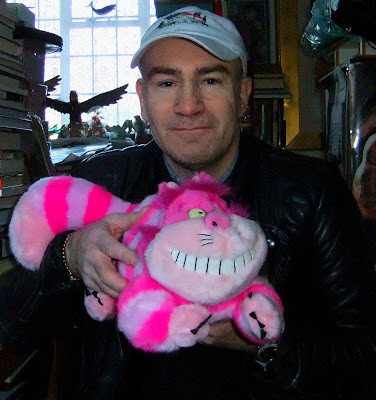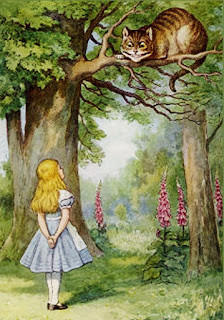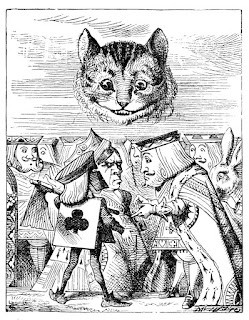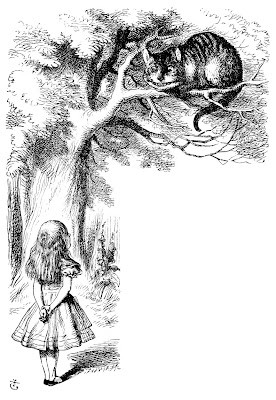Lewis Carroll’s Alice’s Adventures in Wonderland introduced the world to a character as enigmatic as its grin – the Cheshire Cat. This fantastical feline, famous for its slow disappearance leaving only its mischievous smile behind, has captivated readers for generations. But where did Carroll’s inspiration for this surreal creation originate? The phrase “Cheshire Cat Smile” itself predates Carroll’s work, but the depth and layers of meaning he imbued into this literary device continue to fascinate. Let’s delve into the possible origins of the Cheshire Cat smile, exploring the historical, cultural, and perhaps even optical illusions that contributed to this iconic image.
The Enigmatic Cheshire Cat Smile: Unpacking the Grin
The Cheshire Cat isn’t just any cat; it’s a symbol of mystery and whimsical absurdity, largely defined by its persistent and knowing cheshire cat smile. Understanding the roots of this smile requires exploring both the cat’s name and the grin itself, separating fact from folklore and literary license.
The Name’s Origin: Cheshire’s Cats and a Grinning Proverb
While no specific breed is known as a “Cheshire cat,” the name’s origin is geographically straightforward. Lewis Carroll, born Charles Lutwidge Dodgson, spent his formative years in Cheshire, England. Surrounded by the everyday cats of the region – farm cats, pets, and strays – it’s natural that “cats of Cheshire” would come to mind.
Adding to this regional connection, the popular saying “Grin like a Cheshire cat” was already in circulation during Carroll’s time. As Martin Gardner noted in The Annotated Alice, this proverb undoubtedly influenced Carroll’s naming of his grinning feline. The phrase itself hints at a cultural understanding of a particularly broad or fixed smile associated with Cheshire, setting the stage for the cat’s most famous feature.
The Smile’s Inspiration: Unraveling the Mystery
The true allure of the Cheshire Cat lies in its smile. While the name is rooted in location and proverb, the inspiration for the smile has multiple compelling theories, each adding a layer to the mystery.
Cheshire Inns and Grinning Lions
One theory points to the signboards of Cheshire inns. During Carroll’s era, many inns displayed signs featuring lions with wide, often exaggerated grins. These incongruous and somewhat comical depictions of lions could have easily captured Carroll’s imagination, known for his appreciation of the absurd. The image of a broadly grinning lion on a signboard might have been a visual seed for the Cheshire Cat’s distinctive smile.
Cheshire Cheese with a Grin
Another intriguing possibility lies in Cheshire cheese itself. Anne Clark, in her biography Lewis Carroll: A Biography, highlights a medieval figure from Chester, John Catheral, whose family coat-of-arms featured a cat. Legend states Catheral habitually bared his teeth in a grin when angered, and even died with a smile during the defense of Chester. In a unique tribute to his valor, Cheshire cheesemakers reportedly molded their cheeses into the shape of a grinning cat. Carroll, familiar with local customs, would likely have seen these cheeses and understood the story behind their unusual form, directly linking a grin to a “Cheshire cat.”
The Grinning Cat of Brimstage
Venturing into the village of Brimstage, near the modern Merseyside-Cheshire border, reveals another potential source. A medieval stone effigy of a cat exists there, its red sandstone lips sculpted into a distinct grin. Roger Lancelyn Green, in Lewis Carroll, suggests Carroll, an avid reader, might have encountered descriptions of this Brimstage cat, even if he never visited personally. This tangible, historical example of a grinning cat in Cheshire could have further solidified the association in Carroll’s mind.
Grappenhall Church’s Grinning Cat
Reverend Kenneth Lee, Rector of Heswall, documented his search for the Cheshire Cat’s origins in a Cheshire Life article titled ‘The Most Curious Thing I Ever Saw in All My Life’. His investigation led him to Grappenhall church, near Carroll’s childhood home. High on the church wall, above the west window, he discovered a black stone carving of a grinning cat. Lee speculated that Carroll may have seen this carving as a boy, further contributing to the “cheshire cat smile” imagery.
Pott Shrigley’s Wild Cat Crest
Lee’s research extended to Pott Shrigley church, where he noted the Pott family crest – a wild cat – carved under the chancel arch. Intriguingly, he also pointed out that figures outside this church might have inspired other Alice in Wonderland characters, such as the King and Queen of Hearts. This highlights a broader pattern of Carroll drawing inspiration from his Cheshire surroundings for various aspects of his fantastical world, including, potentially, the cheshire cat smile.
Brimstage Hall’s Misunderstood Lion
Returning to Brimstage, Lee examined the stone cat corbel in the ancient chapel, also the namesake of a local inn. This statue is believed to be linked to the Domville family of Brimstage Hall, whose coat-of-arms featured a red lion. The theory suggests a stonemason, unfamiliar with lions, was commissioned to carve one. The result, some believe, was a feline figure with a grin rather than a fierce snarl – a humorous misinterpretation that mirrors the Cheshire Cat’s ambiguous smile.
The Vanishing Act: An Optical Illusion at Croft Church
Beyond the smile, the Cheshire Cat is equally famous for its vanishing ability, leaving only its grin behind. A remarkable discovery at St Peter’s Church in Croft, where Carroll’s father was rector, offers a potential explanation for this unique trait.
The Croft Church Discovery
In 1992, Joel Birenbaum, a member of the Lewis Carroll Society, visited St Peter’s Church in Croft. Kneeling at the altar, he noticed a small, stone-carved grinning cat on a wall panel. What happened next was extraordinary.
The Optical Illusion Explained
As Birenbaum knelt lower and looked upwards at the carving, the cat’s image appeared to vanish, leaving only its wide cheshire cat smile visible. This optical illusion, due to the angle of perspective, meant that from a certain viewpoint, the cat’s body seemed to disappear while its prominent grin remained. This real-world phenomenon, observed in a church Carroll frequented as a child, provides a compellingly direct inspiration for the Cheshire Cat’s vanishing act and lingering smile.
A Tapestry of Inspirations: More Than Just One Source
It’s unlikely that the Cheshire Cat and its smile sprang from a single source of inspiration. Instead, it’s more probable that Carroll, a keen observer of his surroundings and a master of weaving together disparate threads, drew from a rich tapestry of influences. The “cheshire cat smile” we know and love is likely a composite creation, shaped by Cheshire folklore, grinning figures in local art and architecture, regional sayings, and even optical illusions.
The enduring appeal of the Cheshire Cat, particularly its iconic cheshire cat smile, lies in this very ambiguity and multifaceted origin. It’s a character born from a blend of cultural references, personal experiences, and Carroll’s boundless imagination. The Cheshire Cat’s grin continues to be one of literature’s most recognizable and debated smiles, second perhaps only to the Mona Lisa’s enigmatic expression, securing its place as a truly unforgettable literary feline. Not bad for a character absent from Carroll’s original manuscript, proving that sometimes, the most enduring smiles are those that appear unexpectedly and linger long after the rest has vanished.
[





